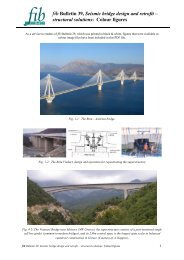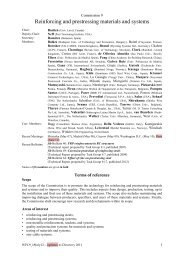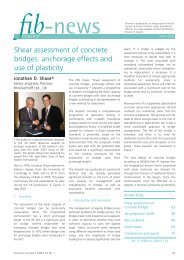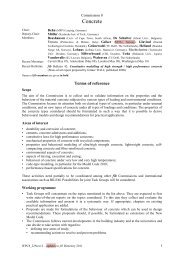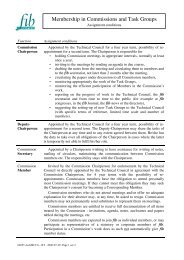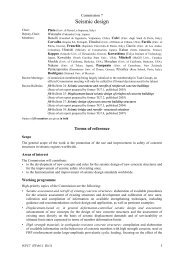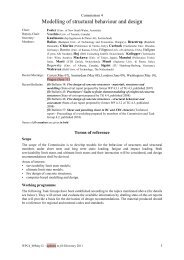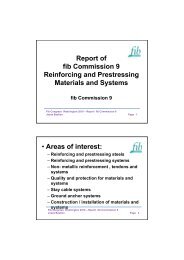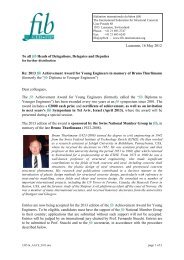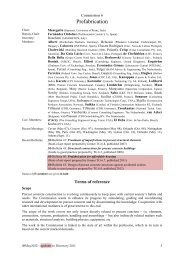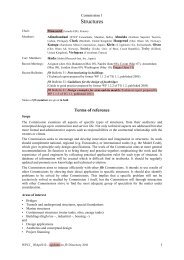Construction - The International Federation for Structural Concrete
Construction - The International Federation for Structural Concrete
Construction - The International Federation for Structural Concrete
You also want an ePaper? Increase the reach of your titles
YUMPU automatically turns print PDFs into web optimized ePapers that Google loves.
Commission 10<br />
<strong>Construction</strong><br />
Chair: van der Horst (BAM Infraconsult, <strong>The</strong> Netherlands)<br />
Deputy-Chair: to be nominated<br />
Secretary: Schmitt (SNCF - IGOA, France)<br />
Members: Burtet (VSL, Switzerland), Cayron (Bouygues Travaux Publics, France), Contreras (Arup,<br />
Spain), Fischer (TU Munich, Germany), Heggade (Gammon, India) Herrero (Ferrovial –<br />
Agromán, Spain), Imberty (Ministère de l’Equipement, France), Klein (T ingenierie SA,<br />
Switzerland), Magyar (Hídépítö, Hungary), Mancini (Politecnico Torino, Italy), Portenseigne<br />
(Bouygues Travaux Publics, France), Primault (Vinci <strong>Construction</strong>, France), Rombach (Techn.<br />
Univ. of Hamburg-Harburg, Germany), Sanchez (Roughan & O’Donovan, Ireland), Srinivasan<br />
(Arup, United Kingdom), Turmo (Univ. Politecnica de Catalunya, Spain)<br />
Corr. Members: Curtis (RTR Bridge <strong>Construction</strong> Services), Buron Meastro (IECA, Spain), Geiker (Techn.<br />
Univ. of Denmark, Denmark), Jensen (MT Højgaard, Denmark), Magyar (Hídépítö, Hungary),<br />
Mancini (Politecnico Milano, Italy), Öberg (NCC AB, Sweden), Tassin (<strong>International</strong> Bridge<br />
Technologies, USA)<br />
Recent Meetings: Paris (Oct. 06), Paris (Oct. 07), Amsterdam (May 08), Paris (Nov. 08), London (June 09),<br />
Paris (March 10), Paris (May 10), Paris (January 11), Paris (March 11), Paris (May 11),<br />
Paris (Nov. 11), Paris (April 12), Paris (June 12), Paris (Dec. 12)<br />
Recent Bulletins: fib Bulletin 48: Formwork and falsework <strong>for</strong> heavy construction<br />
(Guide to good practice prepared by <strong>for</strong>mer TG 10.2, published 2009)<br />
Names of fib members are given in bold<br />
Scope<br />
Terms of reference<br />
<strong>The</strong> Commission addresses state-of-the-art basic principles of the construction process of concrete<br />
structures at site. It also reflects on anticipated developments, which could have a significant influence<br />
<strong>for</strong> construction. <strong>The</strong> objective is to develop awareness regarding aspects which have an impact on<br />
safety, serviceability, durability and environmental issues of concrete structures to be build at site, and<br />
to provide in<strong>for</strong>mation as how to handle the basic principles. <strong>The</strong> output will be presented as<br />
internationally harmonized reports.<br />
Areas of interest<br />
<strong>The</strong> areas of interest have been developed from the viewpoint that the construction process has two<br />
main components: perception-related aspects and process aspects. <strong>The</strong> perception-related aspects<br />
comprise materials, workmanship, <strong>for</strong>mwork and scaffolding, curing of concrete, concrete surface,<br />
testing and monitoring, high per<strong>for</strong>mance concrete, special technologies, specifications and<br />
training/education. <strong>The</strong> process related aspects comprise the construction process of concrete<br />
structures, quality management and life cycle management.<br />
Each of the areas can be summarized as follows:<br />
1. <strong>The</strong> construction process of concrete structures, including process management, environmental<br />
aspects, traceability of products and activities, preparation and workmanship, the construction<br />
phase and its impact on durability, strategic choice of materials<br />
2. Quality management: principles and criteria, guidelines <strong>for</strong> implementation. ISO 9000-2000<br />
principles, global versus detailed process/indicators<br />
3. Materials: packaging, transportation, storage and handling<br />
4. Workmanship: mixing, casting and post casting treatment of concrete, detailing and installation of<br />
rein<strong>for</strong>cement and of prestressing, both steel and carbon rein<strong>for</strong>cement<br />
5. Formwork and scaffolding: principles, systems and details, design, erection and striking<br />
WPC10_12Mar13 – updates to fib Directory 2011 1
6. Curing of concrete: moisture curing of concrete and early age crack control, cooling and heating of<br />
concrete, protection of the concrete surface after casting<br />
7. <strong>Concrete</strong> surface: quality and texture<br />
8. Testing, monitoring and control during construction: destructive / non destructive testing, in-situ<br />
monitoring, crack width control<br />
9. Life cycle management (LCM) (construction phase aspects only): basic principles, birth certificate,<br />
demolition plan<br />
10. Special materials: high per<strong>for</strong>mance concrete (strength and workability)<br />
11. Special technologies: equipment and robots, ICT in construction (4D Cad, Cam, Data<br />
communication and project management)<br />
12. Specifications <strong>for</strong> materials and workmanship<br />
13. Training and education<br />
Working programme<br />
<strong>The</strong> first Commission 10 publication, fib Bulletin 48, “Formwork and falsework <strong>for</strong> heavy<br />
construction” (Guide to good practice) was published in January 2009.<br />
<strong>The</strong> work of the Commission is currently focused on preparing a state of art in<strong>for</strong>mation and the<br />
design specifications <strong>for</strong> precast segmental construction of bridges. <strong>The</strong> main aspects that will be<br />
considered are related to the construction, to the assembly and to the design both of segments and<br />
bridges, with internal and external or mixed prestressing. <strong>The</strong> following aspects will be considered in<br />
detail:<br />
concreting and curing of precast elements: one sequence concreting, partial concreting, concreting<br />
position, delay or conditions <strong>for</strong> the first move of the element, curing of element, surface<br />
preparation or treatment be<strong>for</strong>e coupling or glueing of the joint;<br />
transportation and storage of different segments;<br />
assembling by means of: launching girder, four wheel winches acting on the top of the deck, crane<br />
trucks acting from the bottom, tower cranes mounted on rails or a combination of previous<br />
systems; if necessary with use of temporary stays;<br />
temporary prestressing during the assembling and epoxy resin (or other material) used during the<br />
coupling of joints, ducts coupling, thightness in the joints;<br />
shear keys design and their distribution along the perimeter;<br />
positioning of anchorages of construction and continuity tendons;<br />
deviators <strong>for</strong> external prestressing;<br />
camber in construction and geometry corrections <strong>for</strong> the cantilever (construction on a jack system<br />
and final adjustment be<strong>for</strong>e the connection of bearings);<br />
conceptual design in the choice of span sequences, geometrical profile (constant of variable depth);<br />
use of extremity counterweight <strong>for</strong> orographic reasons;<br />
prestressing layout <strong>for</strong> internal, external and mixed prestressing;<br />
particular design models <strong>for</strong> the ULS, to be adopted in presence of joint opening and different type<br />
of prestressing;<br />
durability aspects related to the use of tendon anchorages within the joints, to the ducts to be used<br />
<strong>for</strong> internal tendons, in particular crossing the joints and to the type of duct grouting.<br />
<strong>The</strong> resulting bulletin will summarize the experience cumulated in construction of precast segmental<br />
bridges all around the world and will give to the designer a guide to conceive economical and<br />
per<strong>for</strong>mance based bridges assembled by precast segments. Publication is targeted <strong>for</strong> 2012.<br />
WPC10_12Mar13 – updates to fib Directory 2011 2



